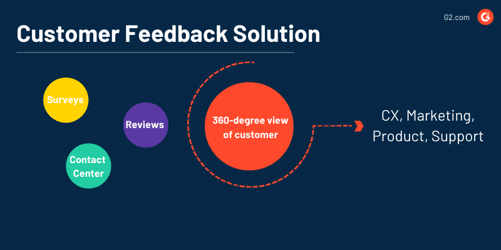February 10, 2021
 by Alyona Medelyan / February 10, 2021
by Alyona Medelyan / February 10, 2021

There are plenty of customer feedback management solutions out there, but most of them are survey platforms with fancy features.
They make it easy to collect feedback via a survey and create simple dashboards, but they fail for two reasons. First, they make it seem like all other feedback doesn’t matter. Think live chat data on your website, reviews on different sites, like G2, or even feedback buried in your CRM. Second, they tend to ignore the richest feedback of all: people’s responses in free text. Most present word clouds or generic buckets.
An ideal solution should help you organize and access all feedback that matters to your customers. It should also provide the highest possible feedback analysis. Let’s break it down.
A customer feedback analysis solution is focused on analysis, rather than collection of feedback. It should be agnostic to how you collect your feedback, and instead use the feedback you already have. It could be feedback from surveys, support tickets, live chats, reviews, complaints and emails. A customer feedback analysis solution helps you digest this data into insights important for making strategic decisions in your business.
For example, let’s say you are in charge of in-flight experience. You want to decide what to implement next. Ideally, you want a feedback analysis solution where you can zoom in on only the feedback about “in-flight experience”, regardless of channel, and then answer questions like: Solving which issue will give me the greatest impact? Is it seat comfort, the loud announcements from the cockpit, snack availability or bathroom smell? Imagine having the answer at the click of a button!
Why do you need a separate customer feedback solution, since so many survey platforms already have analytics built in? This is because it is impossible to put all customer communication through a single tool. Most companies use at least 5 systems to communicate with their customers: a contact center solution, a complaints center, satisfaction surveys, online chat system, public feedback systems. As a result, each of these systems has their own analytics and there is no way of reconciling the insights.

Generating feedback has never been easier but feedback itself remains an underutilized resource. Customer feedback management solutions make it easy to respond to individual feedback, which is great. But what about making strategic decisions and prioritizing?
In the best-case scenario, analysts and data experts provide insights to inform decisions. These people are capable and smart. But they often cannot take advantage of all feedback out there, because turning feedback into quantified insights is hard and the tools they use are limited.
Scraping reviews or combining datasets requires not just analytical, but also development skills. Neither Excel nor a visualization tool like PowerBI can find themes in feedback. A customer feedback analysis solution would help them overcome these challenges.
The best data-driven companies implement customer feedback analysis solutions to find ways of growing faster and more efficiently.
Keeping feedback top of mind makes everyone focused on the customer and what matters to them. Most companies have centralized all sales data in a CRM, but when it comes to feedback, it’s scattered across survey results, review sites, support tickets, contact center transcripts, interview notes, research studies, and sales conversations.
We are not saying that customers know all the answers. But they know what’s painful, and will tell you where you fall below their expectations. When making strategic decisions, this knowledge must be a source of problems that need to be addressed.
You can guess and hypothesize, but feedback will tell you whether customers care about something or not, or whether your experiment worked or failed.
The instant business outcome from using a customer feedback analysis solution is the gain in efficiencies within the team and the improvement in employee satisfaction. Analyzing feedback manually is a tedious task that takes a lot of time. Investing into automated analysis solutions will mean getting answers within minutes instead of hours, and that your team can focus on value-add work. But ultimately, there are even greater outcomes to gain here...
First, it’s important to understand that being customer centric and caring about what customers say in their feedback isn’t something that has an instant and quantifiable return on investment (ROI). It’s a long term game.
Take for example lead management and digital advertising. If you spend an X amount of money to run an advert and as a result you can receive Y number of leads, your ROI is clear. When you invest into analyzing customer feedback, your benefits won’t be immediate. First of all, they depend on the quality of the feedback you collect and the accuracy of the analysis. Second, the benefits depend on whether you actually act on this feedback.
Assuming, your customer feedback strategy is right and the solution you use for analyzing feedback provides accurate results, and you act on them, the outcomes for the business could be transformative:
There is no business that wouldn’t want fast and sustainable growth with operational efficiencies. And yet, many companies are still focused on surveys rather than analysis. This can be explained by looking at a business maturity model in this new emerging space.
So many business processes we use today did not exist as recently as 20 years ago. Think about a CRM. It used to be known as the roller deck and lived in the head of the top sales people in the company. Similarly, focus on customer feedback is something that’s fairly new.
Here is what a customer feedback analysis maturity model looks like, based on our conversations with many different companies.
A company might commission a market research agency or do this research in-house by looking at feedback that arrives through any of the possible channels. Typically, the purpose of this research is to help with strategic direction, but in this stage it’s done in an ad hoc way.
Feedback is collected continuously and looked at regularly, but not all the time. An analyst might put together a quarterly report on key insights in feedback and share with the board and the teams.
A company invested into a feedback management platform that has first dashboards summarizing customer feedback metrics and high level themes. These are available to teams at any point, and they can easily read comments for additional context.
A company has easy access to both high-level themes and in-depth analysis of feedback. Dashboards provide not just metrics but also what’s driving them based on free-text feedback. It’s possible to see emerging themes and trends.
A company has invested into a unified feedback analytics technology. It combines across all feedback sources, enriches this feedback with financial customer metrics such as spend and lifetime value. Teams can easily access insights in a self-service manner, but they are supported by analysts focusing on feedback insights who know how to interpret the data.
Now that you know what these stages are, how would you place your company on this customer feedback analysis maturity curve?
Here's how Atom Bank used a customer feedback analysis solution to reduce call center volume:
Atom Bank, UK’s first digital bank, is a great example. They use a customer feedback analysis solution to keep customer point of view top of mind and drive improvements to their user experience and call center efficiencies.
Michael Sherwood, Head of Customer Experience at Atom Bank, decided to use a feedback analysis solution when he realized that feedback arrives at the company through many different channels and systems.
For example, app reviews were listed on App store, independent reviews were listed on Trustpilot, they run customer surveys through a customer experience platform and complaints and customer chat through a CRM. As a result, each of the tools that was used to monitor this feedback provided a different view into what mattered to customers.
Michael’s vision was to pull all feedback from eight different sources into a single view. He researched into customer feedback analysis solutions that don’t solicit feedback but rather pull it from other systems and analyze it consistently.
Now that such a system is in place, when Atom Bank sees an issue bubble up, regardless of the source, they can validate its priority quickly and address it. For example, they saw that users struggle to add another device to their account. A product owner of this feature could instantly find all relevant feedback, which devices were used and IDs of customers to follow up with.
Once the issue is addressed, they can validate whether it was successful. For example, they can see 40% less people had issues with adding another device based on what they wrote in their feedback. This means that the solution has been effective. And they can also observe a drop in contact center requests, so they could also quantify the financial impact of finding this issue and solving it.
Atom Bank uses this unified approach to feedback analysis to continuously find and fix issues users bring up in their feedback. The results are impressive. They became the most trusted digital bank on Trustpilot and won numerous awards for their Customer Experience.
Convinced? Let’s dig deeper into how to get started.
Start with a collaborative session with a representative from each of your teams. Do they gather feedback? Where have they seen customers leave feedback?
Here are possible sources:
Internal feedback is more valuable because you can enrich it with other customer data. For example, the tenure of the customer, how much are they spending, and other metadata.
If your data is spread across different systems, some customer feedback solutions provide professional services to help you blend/enrich data.
Having all feedback in one place is called unified feedback analytics, but it doesn’t mean that feedback has to be locked in that system. It can and should be integrated into other tools people use. For example PowerBI dashboards that report business metrics should also include themes in customer feedback.
Sites like G2 are perfect to get a shortlist of feedback analysis solutions. You can use the review to verify whether your use case and industry is catered for well. Make sure to ask questions that will help you during the buying process, such as what the DIY capabilities are like.
Get a trial. Many solutions offer a free trial. You can upload your data and can see the themes that are discovered and the interface. However, if you have custom requirements, expect to pay for a proof of concept.
Amazon is known for using an empty chair in a meeting reserved for an imaginary customer. But if you have a customer feedback analysis solution, the chair doesn’t need to be empty. Imagine having all those things that customers say in one place! Imagine being able to ask your customers any question during any meeting and instantly get an answer!
If growing faster or maintaining your level of growth is top priority, feedback has some of the key answers you’ll need. Stop ignoring it in favor of hard numbers. If analyzed correctly, feedback has both hard numbers, as well as more depth and nuance. Start today by implementing a customer feedback analysis solution, and you’ll be surprised by the things you’ll learn about your customers.
Alyona Medelyan, Ph.D. is the CEO of Thematic, a customer feedback analysis solution, a fast and reliable way to gain deep insights into what drives customer satisfaction and loyalty. Alyona’s publications in Natural Language Processing have been cited by more than 2500 researchers.
Digital survey sharing methods like SMS messaging, emails, web intercepts, and chat link URLs...
 by Vinod Janapala
by Vinod Janapala
Since India has become one of the fastest-developing economies in the world, its poverty is on...
 by Vinod Janapala
by Vinod Janapala
As the customer experience becomes more digital, consumer feedback represents the cornerstone...
 by Nahla Davies
by Nahla Davies
Digital survey sharing methods like SMS messaging, emails, web intercepts, and chat link URLs...
 by Vinod Janapala
by Vinod Janapala
Since India has become one of the fastest-developing economies in the world, its poverty is on...
 by Vinod Janapala
by Vinod Janapala


